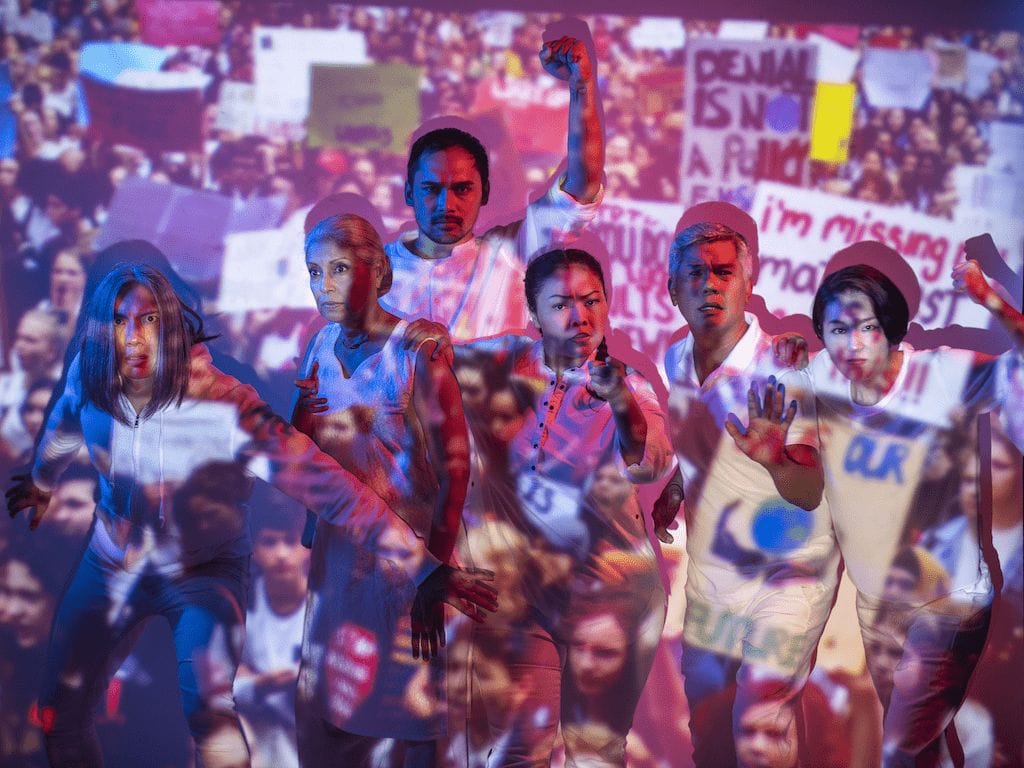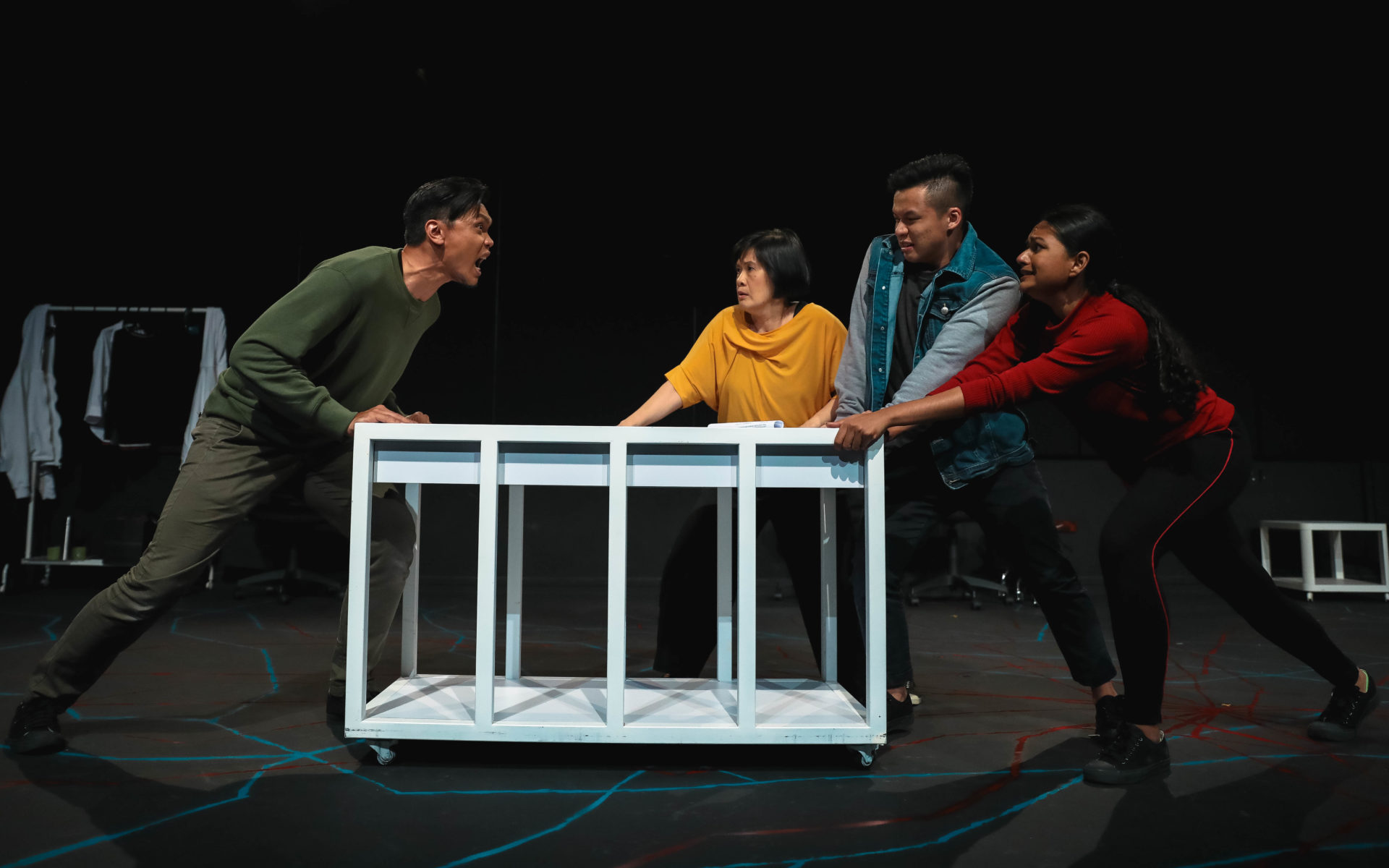Coming Back From The Year of No Return — In Conversation with Haresh Sharma
I have to admit I didn’t know who Haresh Sharma was when I first met him. It was two years before interviewing Haresh Sharma for The Year of No Return. I signed up for a playwriting and acting course at the Birds Migrant Theatre, a local theatre group comprising migrant workers in Singapore. And as I went through the playwriting part of the course, I had to write a short play to be reviewed. Haresh was the one who took a look at my play.
Ignorance is bliss. If I were any other writer, I would have been gobsmacked. Here was the playwright who wrote Off Centre, the landmark play by The Necessary Stage. He was friendly, humble.
I had the privilege of working with him for two plays by the Bird’s Migrant Theatre. As he devises new works, he invites you to explore, to play. He trusts your voice and your point of view. He tries to mould it into the play, becoming a kaleidoscope of ideas and perspectives.
It’s the same for The Year of No Return. In ideating the piece, he was happy to let the choreographer conduct a workshop at the beach for the production’s artists and actors. ‘
I spoke with him last Saturday about The Year of No Return, for which he’s one of the playwrights. He joined me over Zoom, donning black-rimmed glasses and a black t-shirt.
*The conversation has been edited for length and clarity.
No Time to Read? Here’s a Snappy Summary of This Article
- Creative Resilience: Playwright Haresh Sharma discusses navigating challenges and finding creative resilience after a tumultuous year.
- Art Amidst Crisis: Sharma reflects on how the arts industry coped and adapted during the “Year of No Return,” highlighting the power of artistic expression in difficult times.
- Community Connection: The interview explores how Sharma’s work fosters a sense of community and provides a platform for dialogue on societal issues.
- Inspiration from Struggle: Sharma shares insights into drawing inspiration from personal and collective struggles, channeling them into impactful narratives.
- Theater’s Transformative Role: The conversation delves into the transformative role of theater, shedding light on its ability to provoke thought and bring about change.
- Hope and Moving Forward: Despite challenges, Sharma remains hopeful about the future of the arts, emphasizing the importance of storytelling in shaping a better society.
The production started innocently enough back in 2018. They were looking to create a production that could include international artists. Climate change seemed to be able to unify the voices of these artists. Then they found out that 2020 was what some scientists called ‘the point of no return’.
‘Because, in the past, a lot of countries were just ‘playing around’ with climate change. Like ‘okay, let’s recycle’, or ‘let’s use more solar energy’. But it wasn’t being taken as seriously as it needed to be,’ Haresh told me. ‘We thought that’s an interesting topic, and so that’s why we wanted to do something around the issue of climate change with our title—‘The Year of No Return’.
The production was originally slated for SIFA 2020. But, as you know, the pandemic hit. New realities hit: social distancing, lockdowns, masks—you know the drill.
But with new realities come new perspectives. ’The pandemic is a by-product of climate change. It’s also about human behaviour, it’s also about mental health. It’s about how we treat animals and plants.’ Haresh props up on his chair. ‘The more we researched, the more we realised we’re all so interconnected, that the virus comes from human folly, so to speak.’

‘It was a lot of work. We were constantly writing and rewriting. But it was also fulfilling. Because we were able to make the work more current. We could talk about inequality now as vaccination came into play.’
Then there were lockdowns and travel restrictions. The international artists that they were collaborating with for The Year of No Return weren’t allowed to visit Singapore.
‘We had four actors from overseas. Two from Manila, one in Kuala Lumpur, and another one in Tokyo. So we had to arrange to be filmed in their own cities, and then we compose the work (for the stage), with both the live elements and the film elements.’
The production soon morphed into a logistical nightmare. They needed to find recording studios in each of those cities, not to mention all the equipment required for the recording.
Read Also: How I Got Close to My Mother
Max Tan, the costume designer, had to nail down the costumes and props at a moment’s notice. Because they had to ship all of it across 3 different cities. Some got stuck at a warehouse. So their team had to track down the logistics company so that their parcel could arrive on time.
Perhaps this is where we can see Haresh’s reflection of our interconnectedness, how people need to come together. When they needed to rework the script, Haresh bounced ideas off Rody Vera, another playwright in the Philippines who works on the production. The set designers and costume designers shared ideas on how to change the set.
‘You know, it takes a village to put up an entire play. Yet everyone was so willing to come together despite all the changes. Whether it was the stage manager or the administrator, everyone was doing what they had to do, and they did it!’
A feat, considering they were rehearsing The Year of No Return during the thick of the pandemic. Imagine this, the actress in KL is being filmed in the studio by the crew there, and then Haresh is all the way in Singapore, watching it and giving directions and notes on Zoom.
But there’s another actor in Manila. He also has to get on Zoom to have that conversation, even if they were filming only the actress.
Despite that chaos, they managed to create a comprehensive piece that looked at how the decisions affecting our planet are in the hands of the big players: the corporations, the politicians. It also delves into how the drastic changes could be affecting our collective mental health too.

And The Year of No Return looks to be a feat of interdisciplinary art, combining not only the live performance of the actors on stage, the digital video feed of the actors overseas, and the choreography of multimedia on stage.
While incorporating new elements, or digital elements for that matter, might feel new. Theatre is no stranger to constant evolution. But the way we experience stories and the arts has been shifting towards the digital since before the pandemic. So I posed him this age-old question: how will the theatre stay relevant?
‘I think storytelling in any form will always be relevant. People always want to hear stories, and it’s our responsibility to tell more stories than ever. Because, for a long time, a lot of stories have been suppressed.’
‘That one thing about Theatre is that we can adapt to the environment to the changes. Yes, we love going to the theatre because it’s a whole experience—you watch the actors live, and you talk about it with your friends. I think that will continue, even though at the moment it is with a drastic reduction in audience size. But at the same time, I think artists are responding to the environment by creating new forms to capture today’s ethos.’

As for capturing new audiences, Haresh thinks that having diversity and variety matters, beyond the few of us who like theatre, and the few of us that can afford it. He points to Drama Box that stages outdoor theatre, and the annual Red Dot Festival, which features migrant stories.
‘For me, it’s really about finding the different opportunities and platforms to create theatre. And not just create theatre with professional actors, but with all kinds of participants.’
Maybe that’s what we need to do: to come together and share our stories. Maybe then, we can share our hopes and learn to stop and listen—especially when we’re facing so much uncertainty, what with the state of the world now.

Since theirs is a production that ‘seeks to question whether we live in an age of despair—or one of hope in the dark,’ I asked Haresh, how does he navigate this ‘age of despair’ and find hope?
‘I think there’s something about being theatre people where we live through this despair and we live through joy. We live through, you know, our rollercoaster emotions with the support from one another. And I think that is something that I would say has kept me going for the past 30 years.’
‘Because in dark times and in difficult times you depend on each other. And then in happy moments, you celebrate together. Maybe it’s a kind of bubble that we live in for the theatre community. It’s different from the real world.’
‘But I don’t care! Because it is my reality, and the people around me are very supportive. We think about each other all the time, and we reach out to each other in whatever way we can.’
‘So just be there for each other, whenever you can.’
Conclusion
First off, Haresh Sharma is this awesome playwright, and he’s been talking about how he and his team dealt with some major challenges during what he calls the “Year of No Return.” I mean, we all know that 2020 was quite a rollercoaster, right? But Haresh and his crew really took the bull by the horns and showed some serious creative resilience.
They managed to keep the arts alive and kicking even when everything was in chaos. Haresh pointed out how art became this powerful way of expressing feelings and ideas when words just weren’t cutting it. It’s like they turned tough times into this opportunity to connect with the community through their performances and spark conversations about important stuff.
What really struck me is how Haresh Sharma draws inspiration from struggles – his own and the world’s. He takes all that and weaves it into these amazing narratives that hit you right in the feels. And you know what’s cooler? He believes that theater isn’t just about entertainment; it’s this catalyst for change. It makes you think, challenges your perspectives, and pushes society in a better direction.
Amidst all the chaos, Haresh and his team managed to keep the flame of hope burning. They’re super optimistic about the future of the arts. And honestly, it makes sense. After all, stories have this unique way of shaping our world, right?
So yeah, reading this interview got me thinking about how resilient and creative we can be, even in the face of crazy challenges. It’s a reminder that art and storytelling aren’t just hobbies – they’re these powerful tools that can help us heal and grow.
And there you have it, my friend! If you’re into thought-provoking insights, community connections, and a sprinkle of hope, this interview is definitely worth checking out.
In a world that felt like it had hit the pause button, Haresh Sharma and his team hit back with a creative explosion that resonated deeply. The “Year of No Return” might have been tough, but it also became a canvas for resilience and innovation. This interview shines a spotlight on the incredible journey of artists who turned challenges into opportunities.
Sharma’s words reflect the heartbeat of the arts community, showcasing how art and culture can be beacons of light during the darkest of times. The conversation reminds us that amidst the chaos, the human spirit has an uncanny ability to find its voice through creativity. It’s not just an interview; it’s a testament to the power of storytelling and its role in shaping our collective narrative.
As we dive into this inspiring dialogue, it becomes evident that the theater is more than a stage; it’s a mirror that society looks into, questioning norms and sparking conversations that drive change. The interview captures the essence of how art can bridge gaps, connect communities, and foster a sense of togetherness, even when faced with unprecedented challenges.
Haresh Sharma’s insights offer a glimpse into the transformative journey of turning adversity into artistry. His unwavering optimism about the future of the arts industry serves as a beacon of hope for fellow artists and enthusiasts alike. This conversation isn’t just about coming back; it’s about coming back stronger, more connected, and more committed to the incredible power of human expression.
In conclusion, this interview with Haresh Sharma encapsulates the spirit of resilience, the magic of creativity, and the unwavering hope that propels us forward, even from the most trying of times. It’s a reminder that the human spirit is indomitable, and art is our vehicle for navigating the twists and turns of life’s journey. So, dive into this conversation and let the insights inspire you to embrace the transformative magic of storytelling and community, especially in the face of adversity.

Frequently Asked Questions (FAQ)
1. Who is Haresh Sharma and why is he significant in the arts industry? Haresh Sharma is a renowned playwright known for his impactful work in the arts industry, particularly in Singapore. His plays tackle important societal issues and showcase the power of storytelling as a tool for change.
2. What is the “Year of No Return” referred to in the interview? The “Year of No Return” refers to the challenging period marked by unprecedented events and disruptions, including the global pandemic. Haresh Sharma discusses how he and his team navigated these challenges and found resilience through creativity.
3. How did Haresh Sharma and his team adapt during the turbulent times? Haresh Sharma and his team demonstrated creative resilience by using art as a means of expression and connection. They embraced new ways to engage with their audience and fostered community interactions even when traditional avenues were limited.
4. What role does theater play in times of crisis, according to Haresh Sharma? According to Haresh Sharma, theater serves as a catalyst for change during crises. It challenges perspectives, provokes thought, and opens up important conversations about societal issues, offering a unique platform for reflection and growth.
5. How did Haresh Sharma draw inspiration from struggles and translate them into his narratives? Haresh Sharma draws inspiration from personal and collective struggles, channeling them into compelling narratives that resonate with audiences. He believes in the transformative power of storytelling to shed light on pressing concerns.
6. How does Haresh Sharma view the future of the arts industry after facing challenges? Despite challenges, Haresh Sharma remains optimistic about the future of the arts industry. He emphasizes the importance of storytelling in shaping a better society and believes that art will continue to thrive as a source of inspiration and change.
7. Can you provide insights into the impact of art and theater on community connections? Haresh Sharma’s interview highlights how art and theater create a sense of community connection by addressing shared experiences and concerns. They serve as a platform for dialogue, encouraging open conversations and fostering a deeper understanding among individuals.
8. Where can I read the full interview with Haresh Sharma? You can read the full interview with Haresh Sharma on Tropika Club Magazine’s website at the following URL: https://magazine.tropika.club/haresh-the-year-of-no-return/
9. Are there other notable artists in Singapore’s arts scene mentioned in the interview? While the interview primarily focuses on Haresh Sharma, it indirectly sheds light on the resilience and creativity of many other artists and performers in Singapore’s arts scene who faced similar challenges during the “Year of No Return.”
10. How can I stay updated on Haresh Sharma’s future works and projects? To stay updated on Haresh Sharma’s future works and projects, consider following his official social media accounts or visiting the Tropika Club Magazine website for potential announcements and features.

Have an Article to Suggest?
Tropika Club is always looking for new and exciting content to feature in their magazine and they value the input of our readers. If you have any noteworthy content or articles that you believe would be a great addition to Tropika Club’s magazine, we are open to suggestions and encourage you to reach out to us via email at [email protected]. By doing so, Tropika Club values your expertise and knowledge in the matter and appreciates your willingness to help. We will review your recommendations and update our list accordingly
Meanwhile, Check Out Tropika Club’s Ecosystem of Websites

Tropika Club Magazine – Tropika Club Magazine is a Singapore-based publication that features articles on a wide range of topics with a focus on local businesses and content for the region. The magazine emphasizes supporting local businesses through its #SupportLocal initiative, which includes coverage of everything from neighborhood hawker stalls to aesthetic clinics in town. In addition to highlighting local businesses, Tropika Club Magazine also covers a variety of local content, including beauty, lifestyle, places, eats, and what’s on in Singapore and the Asia Pacific region.
Tropika Club Deals – Tropika Club Deals is a leading online deals and voucher shopping site in Singapore, offering amazing discounts on beauty, wellness, and fitness products and services. It’s the perfect platform for customers who want to discover the best deals without having to commit to a specific appointment date and time. These deals are available at major beauty stores, facial salons, hair salons, and other brands in Singapore, with no minimum spend required. Choose from guaranteed discounted deals in the categories of hairstyling, hair removal, facial & aesthetics, body slimming, brows & lashes, nails & makeup, massage & spa or fitness & wellness. Tropika Club Deals is also ideal for customers who want to buy vouchers as gifts or to use for the future. So whether you’re looking to save money on your next haircut or want to treat yourself to a relaxing massage, Tropika Club Deals has got you covered with the best voucher and coupon deals in Singapore!




